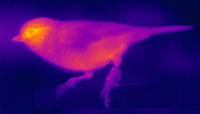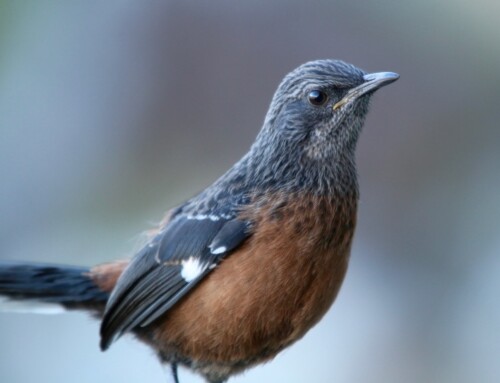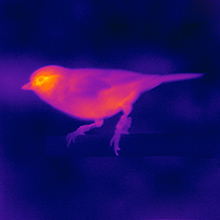
Thermal imaging reveals how birds cope with changing environments
LINKED PAPER
Eye region surface temperature reflects both energy reserves and circulating glucocorticoids in a wild bird. Jerem, P., Jenni-Eiermann, S., Herborn, K., McKeegan, D., McCafferty, D.J. & Nager, R.G. 2018. Scientific reports. DOI: 10.1038/s41598-018-20240-4. VIEW
Some changes in the natural environment are predictable, like the perpetual cycle of night and day. But many events, such as variation in food availability, predator attack and human disturbance can’t be anticipated. Wild animals cope with these kinds of unpredictable events by making physiological adjustments, diverting resources towards immediate survival, and away from reproduction (Romero & Wingfield 2015). If an environment becomes too challenging, this process can lead to population decline (Zanette et al. 2011). Falling numbers are usually the first sign a population is in trouble, by which point it may be too late for conservationists to intervene. However, if we could measure physiological changes in wild animals more easily, they might act as an early warning system, enabling us to identify ‘at-risk’ populations before any decline takes place (Fefferman & Romero 2013). And this is where thermal imaging might offer a solution.
Assessing physiological state in free-living animals usually means they need to be trapped and handled, so blood or tissues can be sampled, or so measurement devices can be fitted or implanted. This limits research to species and individuals that can be caught, interrupts natural behaviour, and may alter subsequent physiology. And these factors restrict how representative the findings are, and introduce bias. One alternative strategy is to look instead at traits we can measure without invasive sampling, which relate to underlying physiological processes in a predictable way. Probably the most promising candidate for this job is body temperature, as it’s been linked with a variety of physiological functions, including thermoregulation, metabolic activity, immune response, and stress state.
 Figure 1 Trapping/filming setup for overwintering birds (top), and representative thermal image of bird within trap (bottom). In the thermal image, darker colours represent cooler temperatures, lighter colours indicate warmer temperatures © Paul Jerem
Figure 1 Trapping/filming setup for overwintering birds (top), and representative thermal image of bird within trap (bottom). In the thermal image, darker colours represent cooler temperatures, lighter colours indicate warmer temperatures © Paul Jerem
Measuring body temperature in wild animals used to be as logistically challenging and invasive as any other physiological measure. But in the last few decades, highly portable, video-capable thermal imaging cameras have become freely available, and can be bought for as little as the price of a high-end digital camera. Thermal imaging cameras use the infrared radiation emitted by an object to calculate its surface temperature. This means it’s now possible and practical to measure body surface temperature from free-living animals, non-invasively, multiple times per second.
Our aim was to explore how this exciting opportunity might help us learn about the ways wild animals cope with environmental conditions. We set out to compare body surface temperatures, measured using thermal imaging, with two physiological parameters – body condition and plasma glucocorticoids. Body condition – how heavy an individual is for its size – is essentially a measure of energy reserves. If, for example, food is scarce, low energy reserves can be protected by reducing metabolic rate. Metabolic rate is closely linked to body temperature, so birds in poorer condition should have lower surface temperatures.
Additionally, changes to metabolic rate can be triggered by the stress-induced release of glucocorticoid hormones. Stressful conditions also alter blood circulation – the flow of warm blood to the body surface is restricted, increasing oxygen and nutrient supply to internal organs dealing with the stress. Correspondingly, ‘stressed’ individuals with higher plasma glucocorticoid concentrations should also exhibit lower surface temperatures.
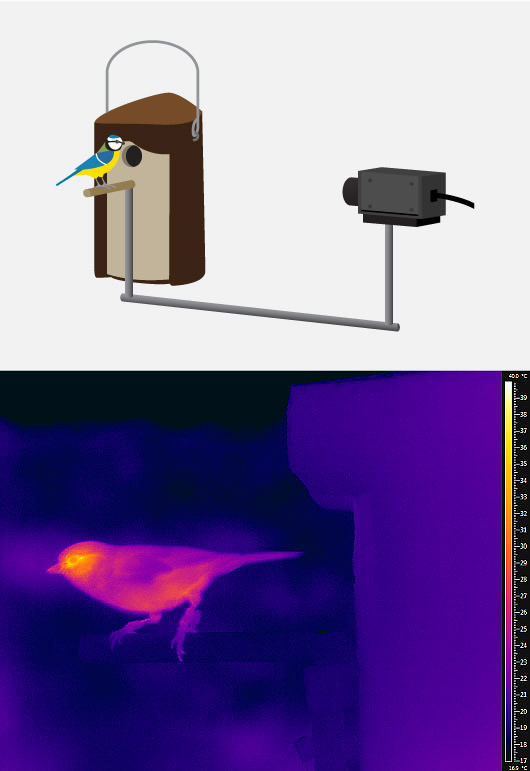 Figure 2 Filming setup for breeding birds (top), and representative thermal image of bird leaving a nest box (bottom). Radio-frequency identification (RFID) tags, like the one visible on the bird’s left leg, were used to distinguish individuals via an antenna mounted around the nest box entrance © Paul Jerem
Figure 2 Filming setup for breeding birds (top), and representative thermal image of bird leaving a nest box (bottom). Radio-frequency identification (RFID) tags, like the one visible on the bird’s left leg, were used to distinguish individuals via an antenna mounted around the nest box entrance © Paul Jerem
We tested these predictions on wild Blue Tits (Cyanistes caeruleus) in the forests around the Scottish Centre for Ecology and the Natural Environment (Loch Lomond). Using techniques borrowed from wildlife photographers and filmmakers (it’s useful to think of thermal imaging as being pretty much like photography, only using a different wavelength), we created two setups to record thermal videos. Both were designed to collect footage from undisturbed birds. This was to avoid body surface temperature changes associated with acute stress (Jerem et al. 2015) obscuring longer-term relationships with physiological state.
The first setup was a specially constructed trap, allowing us to film overwintering birds while they fed inside (Fig 1). Once we’d recorded video for long enough to get a good measure of body surface temperature, we could then trigger the door, capture the bird and take body condition measurements and blood samples to assess baseline glucocorticoid concentrations. The second setup filmed breeding birds, by mounting a camera outside their nest box entrance (Fig 2). Adding a small perch encouraged the birds to pause in front of the lens on their way in and out, as they provisioned their chicks. We took the measurements needed to calculate the breeding parents’ body condition by catching them on the nest a few days before filming.
When extracting body surface temperatures from the resulting thermal videos, we targeted the birds’ eye region. This is because the skin around the eye is the only part of the blue tit body surface where heat transfer to the environment (and so surface temperature) isn’t affected by insulating feathers or the thermoregulatory processes that take place in the legs. Conveniently, the eye region is also usually the hottest part of the image. So, collecting eye region surface temperature was largely as straightforward as selecting the image’s maximum temperature.
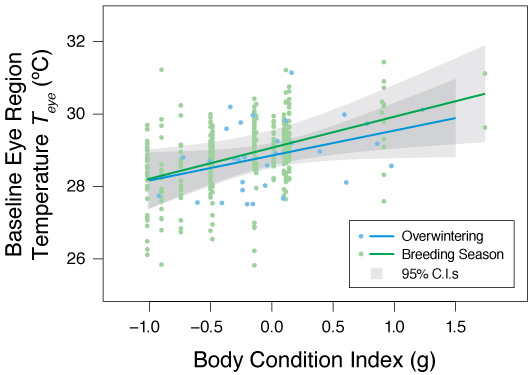 Figure 3 Relationships between baseline eye region temperature and body condition in overwintering and breeding birds. Zero represents mean condition, with positive and negative values indicating body mass (in grams) above or below average, respectively, for a given body size
Figure 3 Relationships between baseline eye region temperature and body condition in overwintering and breeding birds. Zero represents mean condition, with positive and negative values indicating body mass (in grams) above or below average, respectively, for a given body size
Comparing this temperature data with the biometric measurements we’d taken confirmed that in both winter and the breeding season, birds in poorer condition had lower eye region surface temperatures (Fig 3). Given the differences in environmental conditions, the similarity in relationships across these two contrasting times of year is pretty remarkable. Also, analysis of the blood samples taken from the overwintering birds showed lower eye region surface temperatures were indeed associated with higher glucocorticoid levels in those individuals (Fig 4).
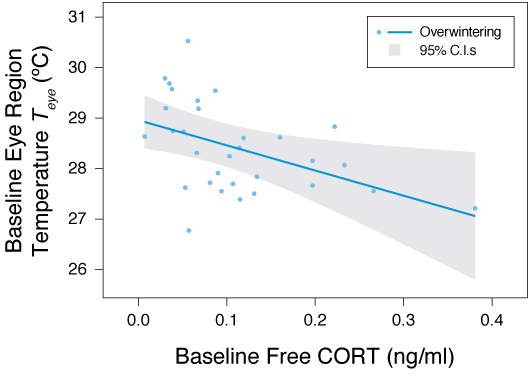 Figure 4 The relationship between baseline eye region temperature and baseline plasma glucocorticoid concentrations in overwintering birds
Figure 4 The relationship between baseline eye region temperature and baseline plasma glucocorticoid concentrations in overwintering birds
Together, these results demonstrate that body surface temperature integrates multiple aspects of physiological state, including processes involved in coping with a changing environment. Consequently, thermal imaging could provide a powerful new way of investigating the responses of free-living animals to environmental challenges. Being non-invasive means thermal imaging is uniquely suited to providing the repeated measurements needed to identify such responses. Plus, the methodological similarities with visible light photography suggest data could be collected from any terrestrial species that has ever been photographed or filmed. As such, this novel method has enormous potential.
References
Fefferman, N.H. & Romero, L.M. 2013. Can physiological stress alter population persistence? A model with conservation implications. Conservation Physiology 1, cot012. VIEW
Jerem, P., Herborn, K., McCafferty, D., McKeegan, D. & Nager, R. 2015. Thermal Imaging to Study Stress Non-invasively in Unrestrained Birds. Journal of Visualized Experiments: JoVE 105: 53184. VIEW
Romero, L.M. & Wingfield, J.C. 2015. Tempests, poxes, predators, and people: stress in wild animals and how they cope. Oxford University Press. VIEW
Zanette, L.Y., White, A.F., Allen, M.C. & Clinchy, M. 2011. Perceived Predation Risk Reduces the Number of Offspring Songbirds Produce per Year. Science 334: 1398. VIEW
Image credit
Featured image: Thermal image of a Blue Tit, Cyanistes caeruleus, leaving a nest box © Paul Jerem
Blog posts express the views of the individual author(s) and not those of the BOU.
If you want to write about your research in #theBOUblog, then please see here.


